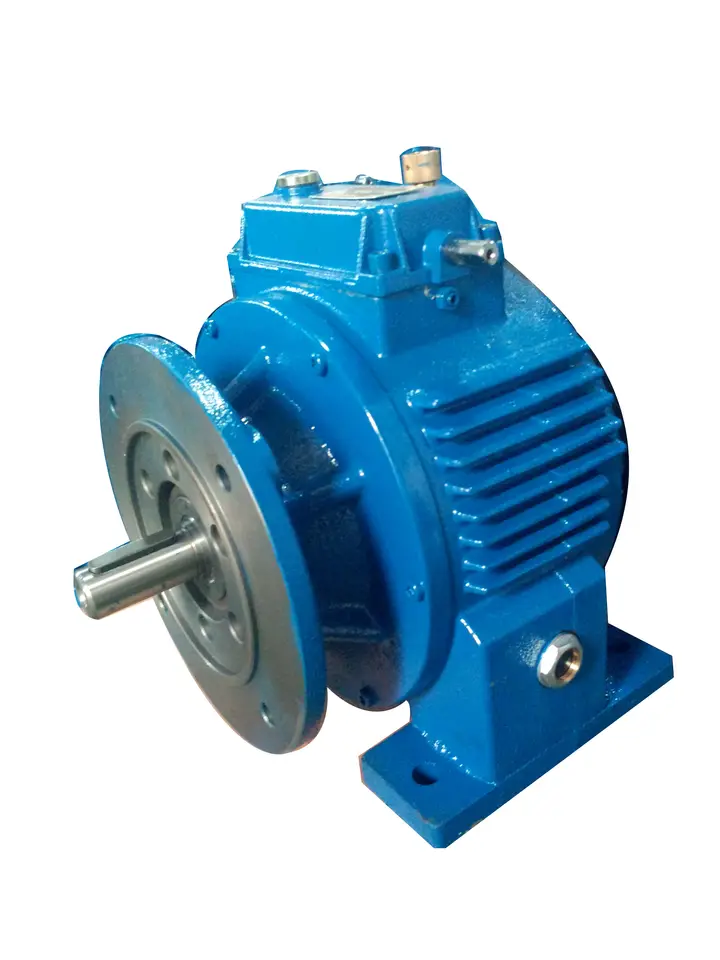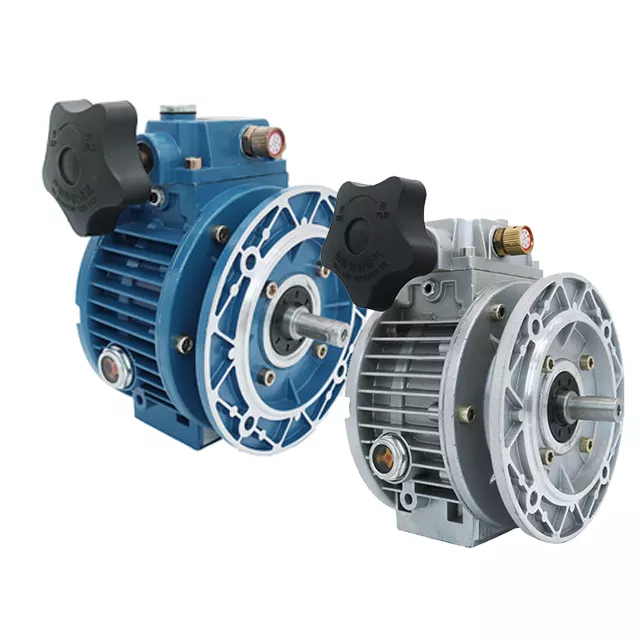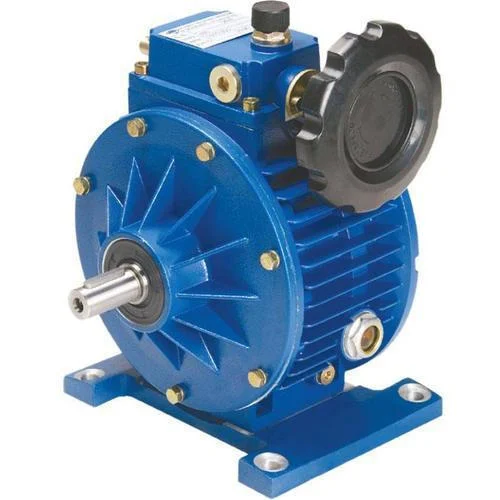Product Description
Stepless speed Variator
High modularity
– Matched with a large range of gearboxes, they are suitable to modular assembling of flanges, feet and torque arms.
High versatility
– 11 sizes, more than 200 versions, with wide range of different mounting positions.
High performances
– Power from 0.18 kW to 7.5 kW.
– Max torque 3000 Nm.
– Up to 6000 Nm when combined with bevel helical gearboxes.
– With the differential device, output speed can be brought to “zero” speed, when the motor is running.
High reliability
– Strengthened box for heavy duty applications.
– Planets and races are made in special steel 100Cr6 and are in oil bath, that guarantee the best conditions of transmission of the motion by friction.
The design of UDL series stepless speed variator compromises the advanced technology both at home and abroad. The products include the following main characteristics:
1. High speed-regulating precision: up to 0.5-1 rotation.
2. Large speed -changing range: The speed ratio ranges from 1:1.4 to 1:7 freely.
3. High in strength and long in service life.
4. Convenient to regulate the speed.
5. Continuous in running, front-to-back in running direction, smooth in driving, stable in performance and low in noise.
6. Full in sealing and suitable for any environment.
7. Compact in structure and small in volume.
8. Made of high-quality aluminum alloy die cast into forming, good-looking in appearance, light in weight and it never gets rusty.
9. Good in adaptation: UDL series stepless speed variators can be combined with all kinds of speed reducers, as to achieve low stepless speed changing.
FAQ
1, Q:what’s your MOQ for udl speed contorller ?
A: 1pc is ok for each type electric gear box motor
2, Q: What about your warranty for your stepless governor ?
A: 1 year ,but except man-made destroyed
3, Q: which payment way you can accept ?
A: TT, western union .
4, Q: how about your payment way ?
A: 100%payment in advanced less $5000 ,30% payment in advanced payment , 70% payment before sending over $5000.
5, Q: how about your packing of speed reduction motor ?
A: plywood case ,if size is small ,we will pack with pallet for less 1 container
6, Q: What information should be given, if I buy electric helical geared motor from you ?
A: rated power, ratio or output speed,type ,voltage , mounting way , quantity , if more is better ,
| Application: | Motor, Machinery, Agricultural Machinery |
|---|---|
| Hardness: | Hardened Tooth Surface |
| Installation: | Horizontal Type |
| Layout: | Bevel |
| Step: | Double-Step |
| Type: | Bevel |
| Customization: |
Available
| Customized Request |
|---|

How do variator gearboxes contribute to optimizing the efficiency of conveyor systems?
Variator gearboxes play a crucial role in optimizing the efficiency of conveyor systems. They offer several advantages that contribute to improved performance, energy efficiency, and overall productivity. Here’s how variator gearboxes help optimize the efficiency of conveyor systems:
- Variable Speed Control: Variator gearboxes enable precise and continuous adjustment of the conveyor’s speed. This variable speed control allows operators to match the conveyor’s speed to the specific requirements of the material being transported or the production process. By running the conveyor at the optimal speed, energy wastage is minimized, and the system operates more efficiently.
- Load Adaptability: Conveyor systems often handle varying loads or different types of materials. Variator gearboxes offer load adaptability, allowing the conveyor to adjust its speed and torque output based on the applied load. This adaptability ensures that the conveyor operates at the appropriate power level, minimizing energy waste during periods of low load or when handling lighter materials.
- Smooth Starting and Stopping: Variator gearboxes provide smooth acceleration and deceleration capabilities, allowing the conveyor to start and stop gradually. This feature reduces stress on the conveyor components, minimizes jerky movements, and prevents material spillage. Smooth starting and stopping also contribute to energy efficiency by reducing power surges and mechanical stress on the system.
- Optimized Power Transmission: Variator gearboxes are designed to optimize power transmission efficiency. They utilize efficient power transfer mechanisms, such as belts or chains, along with well-engineered pulley systems. These systems minimize power losses due to friction and slippage, ensuring that a greater percentage of input power is effectively delivered to the conveyor belt, reducing power consumption.
- Customizable Gear Ratios: Variator gearboxes offer a wide range of gear ratios that can be adjusted based on the specific conveyor requirements. By selecting the optimal gear ratio, the variator gearbox ensures efficient power transfer and reduced power losses. The customizable gear ratios allow the conveyor to operate at the most favorable speed and torque combination, maximizing energy efficiency.
- Integrated Control Systems: Variator gearboxes can be integrated with advanced control systems and automation technologies. These systems enable precise control over the conveyor’s speed, acceleration, and deceleration profiles. By implementing intelligent control algorithms, variator gearboxes can optimize the conveyor’s operation based on real-time production demands, minimizing power consumption and maximizing productivity.
- Maintenance and Serviceability: Variator gearboxes often offer ease of maintenance and serviceability features. They may incorporate features like quick belt tension adjustment mechanisms, easy access to components for inspection and maintenance, and built-in condition monitoring systems. These features simplify maintenance tasks, reduce downtime, and ensure that the gearbox operates at its peak efficiency.
By leveraging the variable speed control, load adaptability, smooth starting and stopping, optimized power transmission, customizable gear ratios, integrated control systems, and maintenance features, variator gearboxes contribute to the overall optimization of conveyor system efficiency. They enable energy-efficient operation, reduce power consumption, enhance material handling capabilities, and improve the productivity and reliability of conveyor systems in various industries.

Are there any limitations or drawbacks associated with variator gearbox systems?
Variator gearbox systems offer numerous advantages, but they also have certain limitations and drawbacks that should be considered. Here are some of the limitations and drawbacks associated with variator gearbox systems:
Limited Torque Capacity:
One limitation of variator gearboxes is their relatively limited torque capacity compared to some other types of gearboxes. Due to the design and construction of variator systems, they may not be suitable for applications that require extremely high torque transmission. In such cases, alternative gearbox systems with higher torque ratings may be more appropriate.
Restricted Speed Ratios:
Variator gearboxes typically have a limited range of achievable speed ratios compared to some other gearbox types. While they offer a continuous and stepless adjustment of the gear ratio, the maximum and minimum achievable ratios may be narrower compared to gearboxes with discrete gear steps. This limitation may restrict their suitability for certain applications that require extremely high or low speed ranges.
Complex Design and Maintenance:
Variator gearboxes can have a more complex design compared to conventional gearboxes. The presence of variable pulley systems, torque-sensing mechanisms, and control systems adds complexity to their construction. This complexity may require specialized knowledge and skills for maintenance and repairs. Additionally, the availability of spare parts and the cost of maintenance can be higher for variator gearboxes compared to simpler gearbox designs.
Potential for Heat Generation:
During operation, variator gearboxes can generate heat due to friction and mechanical losses. The continuous adjustment of the gear ratio and the interaction between the variable pulley system and the belt or chain can contribute to heat generation. Adequate cooling measures and lubrication systems may be necessary to dissipate heat effectively and prevent overheating, especially during prolonged operation at high speeds or under heavy loads.
Efficiency Losses:
While variator gearboxes can maintain reasonable power transmission efficiency, they may experience some efficiency losses compared to certain other gearbox types. The presence of additional components such as variable pulley systems, control mechanisms, and torque-sensing devices can introduce additional friction and mechanical losses, which can slightly reduce overall efficiency. However, advancements in technology and improved designs have mitigated this drawback to a significant extent in modern variator gearbox systems.
Cost Considerations:
Variator gearboxes can be more expensive compared to some traditional gearbox designs. The complexity of their construction, the need for precise control systems, and the use of specialized components can contribute to higher manufacturing and maintenance costs. Therefore, cost considerations should be taken into account when evaluating the feasibility of variator gearbox systems for specific applications.
Despite these limitations and drawbacks, variator gearbox systems continue to offer unique advantages in terms of continuous speed adjustment, efficient power transmission, and precise control. By carefully assessing the specific requirements of an application and considering the trade-offs, it is possible to determine whether a variator gearbox system is the most suitable choice.

What is a variator gearbox and how does it work in mechanical systems?
A variator gearbox, also known as a variable speed transmission, is a type of gearbox that allows for continuous and stepless variation of the output speed within a certain range. It is commonly used in mechanical systems where the output speed needs to be adjusted dynamically without fixed gear ratios. The variator gearbox achieves this by employing specific mechanisms such as belts, chains, or cones.
One common type of variator gearbox is the belt-and-pulley system. It consists of two variable-diameter pulleys connected by a belt. These pulleys can change their effective diameter by adjusting their position. The input pulley is connected to the power source, such as an engine or motor, while the output pulley is connected to the load. By varying the diameters of the pulleys, the speed ratio between the input and output can be continuously adjusted, allowing for a wide range of output speeds.
The variator gearbox works based on the principle of changing the effective radius of the pulleys. When the input pulley diameter increases or the output pulley diameter decreases, the belt is forced to ride higher on the pulley, resulting in a larger effective radius. This causes the output speed to decrease relative to the input speed. Conversely, when the input pulley diameter decreases or the output pulley diameter increases, the belt rides lower on the pulley, leading to a smaller effective radius and an increase in the output speed.
The variator gearbox can be controlled manually or automatically, depending on the application. In manual systems, the adjustment of the pulley diameters is done by the operator using mechanical or hydraulic mechanisms. In automatic systems, the adjustment is typically controlled by a computer or an electronic control unit (ECU) based on various parameters such as speed, load, or user inputs.
One of the key advantages of variator gearboxes is the ability to achieve smooth and stepless speed variation. Unlike traditional gearboxes with fixed gear ratios, variator gearboxes offer infinite possibilities for adjusting the output speed. This flexibility is particularly beneficial in applications where precise control of speed is required, such as in vehicles, industrial machinery, and power transmission systems.
However, it’s important to note that variator gearboxes may have limitations in terms of torque capacity and efficiency compared to traditional fixed-ratio gearboxes. The power transmission efficiency of variator gearboxes can vary depending on the specific design and operating conditions.
In summary, a variator gearbox is a type of gearbox that allows for continuous and stepless variation of the output speed. It uses mechanisms such as belts, chains, or cones to adjust the effective diameter of the pulleys, enabling dynamic speed control in mechanical systems.


editor by CX 2023-10-20
